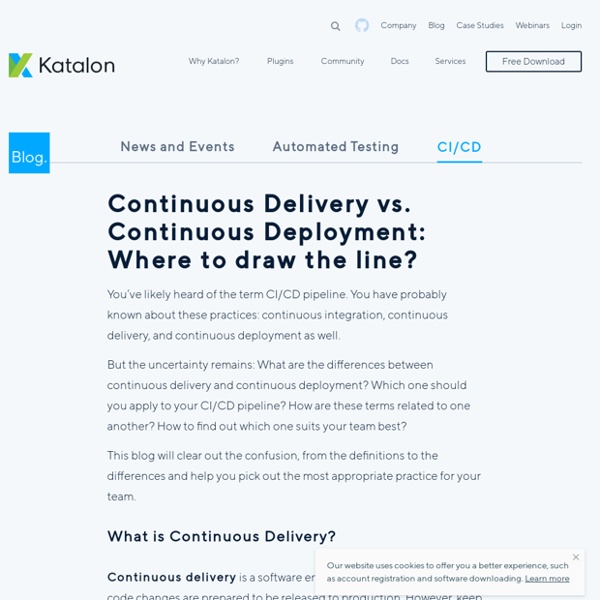



https://www.katalon.com/resources-center/blog/continuous-delivery-vs-continuous-deployment/
Related: allanwalker • kornelia203 • jeffdunn • brian2209CI/CD Pipeline: What, Why & How to Build The Best One On this page: To gain full potential of the software development workflow, developers today must familiarize themselves with the best workflows, practices, and tools. Fast software production is no longer enough to win today’s technology marketplace. Best 14 CI/CD Tools You Must Know “Quality at Speed” is the new norm in software development. Enterprises are making their moves toward DevOps methodologies and Agile culture to accelerate the delivery speed and ensure product quality. In DevOps, a continuous and automated delivery cycle is the backbone that makes fast and reliable delivery possible. This results in the need for proper continuous integration and continuous delivery (CI/CD) tools. A “good” CI/CD tool can leverage teams’ current workflow, to best exploit the automation feature and create a solid CI/CD pipeline, and give teams the boost they need to thrive. If you are new to CI/CD, please check out this blog.
7 Things to Know About the Brand New Katalon Studio 7 The brand new Katalon Studio 7 is here! Katalon Studio 7 (KS7) arrived with a host of enhanced features, promising to deliver an enjoyable automation experience and address the common challenges of the testing community. It also comes with new capabilities tailored for medium and large businesses’ needs. Most of these features and functionalities were suggested by the Katalon Community (you want it, you got it!). That being said, here are a few of our favorite things in KS7! Katalon Studio 7: A Glance Over the Top 7 Features
Desktop Application Testing with Katalon Studio 7 We’ve incorporated desktop application (app) testing to Katalon Studio — starting from version 7.0.0. This addition to the tool’s existing capabilities (web, API, and mobile testing) will transform Katalon Studio into a complete cross-platform test automation solution. See release notes here Katalon Studio for Desktop App Testing Starting from Katalon Studio 7, you can test desktop apps on Windows 10 PCs.
What is Regression Testing? Definition, Tools & How to Get Started What is regression testing? Regression testing is a software testing practice that ensures an application still functions as expected after any code changes, updates, or improvements. Regression testing is responsible for the overall stability and functionality of the existing features. Whenever a new modification is added to the code, regression testing is applied to guarantee that after each update, the system stays sustainable under continuous improvements. Changes in the code may involve dependencies, defects, or malfunctions. Katalon Smart Wait: A New Way to Handle Web Loading Issues For those who are familiar with Selenium WebDriver, one of the most common features is the Wait command. These commands are handy in test scripts execution, or observing and troubleshooting issues that arise due to time lag. Wait commands are powerful — but they also come along with a big problem with timing due to front-end processing. Starting from version 7.0.0, we have introduced the Smart Wait feature that helps you handle Selenium wait issues without any additional test scripts.
Software Testing Trends 2019 Recap 2019 is almost over. The software testing landscape has seen numerous introductions in new testing approaches and innovations at an exponential rate. It has also witnessed the continuation of technological improvement, evolution, and reinvention. As we are progressing to 2020, let’s take a retrospective look at the top trends in test automation and see how we stand after one year. Our team at Katalon has reflected on the most popular trends that took place in the software testing industry over the course of one year. We have compiled the five most influential software testing trends in 2019. Research Done For You (2019 Updated) The third wave of test automation brings about more concepts in software delivery – one of which is ‘continuous testing.’ However, mastering continuous testing is difficult; choosing the right continuous testing tool is even more overwhelming. Using the right tool is incredibly beneficial to your software testing and delivery success.
Top 30+ DevOps Interview Questions Total DevOps Interview Questions & Answers DevOps – a renowned software development practice that many companies adopt into their workflow – has been drawing a great deal of attention. More and more companies have adopted this practice, including large enterprises such as Netflix, Facebook, or Amazon. Best Strategies to Implement for Your Team In today’s rapidly changing world, software products need to be upgraded frequently and quickly to bring value to customers and users. Software features are continuously developed, tested, deployed, and operated in the production environment. New features are not only developed and tested successfully, but they also deployed and operated without much chaos and disruption. Software cross-functional teams which include product owners, software development, quality assurance (QA), operations need to work together to ensure the fast flow of work from development to operation. This requires development teams to be more productive in delivering quality work while QA, operations, and other teams need to use automated tools and follow well-formed practices to minimize their dependence on other teams.
What to Consider Before Applying CI/CD Continuous integration and continuous delivery (CI/CD) is a complex part of any development cycle. It involves continuously integrating code into a shared repository to keep code progression amongst a team of developers running smooth and steady. This helps prevent merging errors, duplicated efforts and promoting collaboration to create a better product. That code is then thoroughly and continuously tested to keep problems from arising.